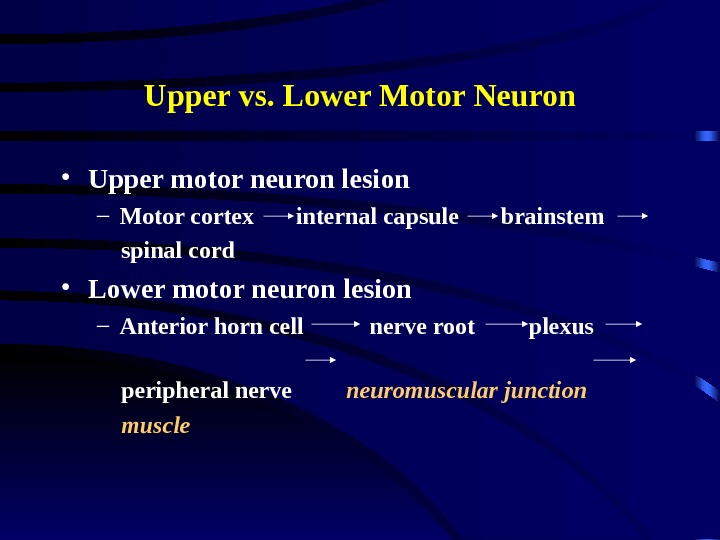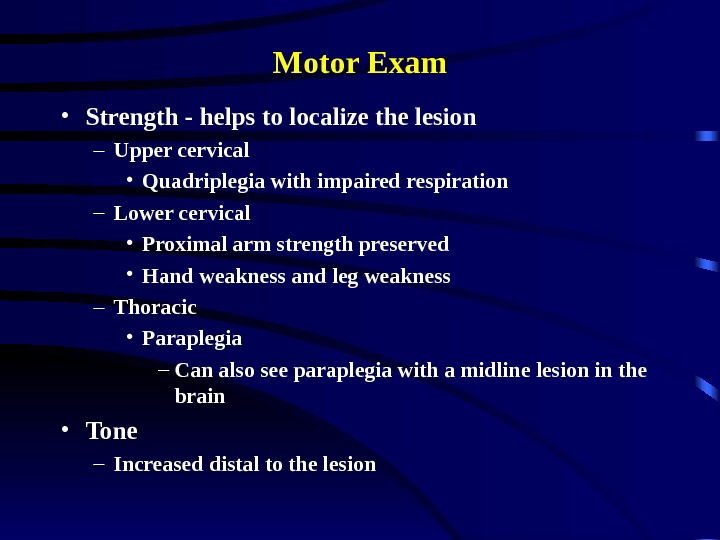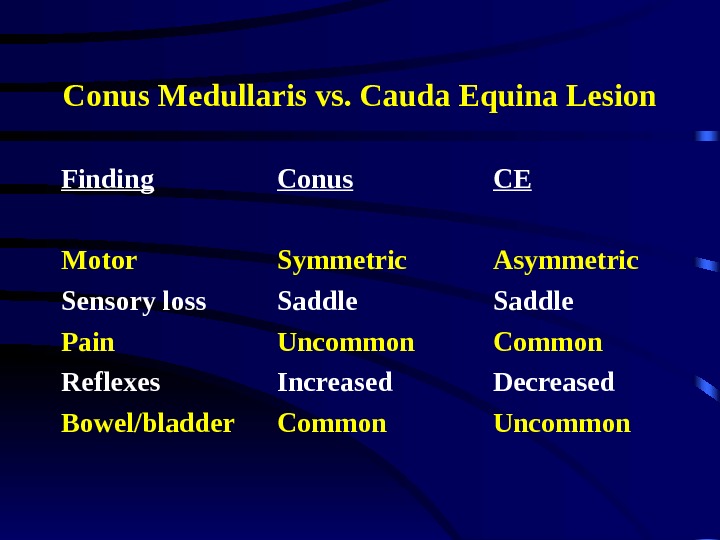Презентация spinal disease
























- Размер: 86 Кб
- Количество слайдов: 23
Описание презентации Презентация spinal disease по слайдам
 Diseases of the Spinal Cord Stacy Rudnicki, MD Department of Neurology
Diseases of the Spinal Cord Stacy Rudnicki, MD Department of Neurology
 Upper vs. Lower Motor Neuron • Upper motor neuron lesion – Motor cortex internal capsule brainstem spinal cord • Lower motor neuron lesion – Anterior horn cell nerve root plexus peripheral nerve neuromuscular junction muscle
Upper vs. Lower Motor Neuron • Upper motor neuron lesion – Motor cortex internal capsule brainstem spinal cord • Lower motor neuron lesion – Anterior horn cell nerve root plexus peripheral nerve neuromuscular junction muscle
 Basic Features of Spinal Cord Disease • UMN findings below the lesion – Hyperreflexia and Babinski’s • Sensory and motor involvement that localizes to a spinal cord level • Bowel and Bladder dysfunction common • Remember that the spinal cord ends at about T 12 -L
Basic Features of Spinal Cord Disease • UMN findings below the lesion – Hyperreflexia and Babinski’s • Sensory and motor involvement that localizes to a spinal cord level • Bowel and Bladder dysfunction common • Remember that the spinal cord ends at about T 12 -L
 History • Onset – Acute, subacute, chronic • Symptoms – Pain – Weakness – Sensory – Autonomic • Past history • Family history
History • Onset – Acute, subacute, chronic • Symptoms – Pain – Weakness – Sensory – Autonomic • Past history • Family history
 Tempo of Spinal Cord Disease Acute Subacute Chronic Trauma Mass lesion X X X Infectious Inherited X X Vascular Autoimmune X X X Nutritional X
Tempo of Spinal Cord Disease Acute Subacute Chronic Trauma Mass lesion X X X Infectious Inherited X X Vascular Autoimmune X X X Nutritional X
 Motor Exam • Strength — helps to localize the lesion – Upper cervical • Quadriplegia with impaired respiration – Lower cervical • Proximal arm strength preserved • Hand weakness and leg weakness – Thoracic • Paraplegia – Can also see paraplegia with a midline lesion in the brain • Tone – Increased distal to the lesion
Motor Exam • Strength — helps to localize the lesion – Upper cervical • Quadriplegia with impaired respiration – Lower cervical • Proximal arm strength preserved • Hand weakness and leg weakness – Thoracic • Paraplegia – Can also see paraplegia with a midline lesion in the brain • Tone – Increased distal to the lesion
 Sensory Exam • Establish a sensory level – Dermatomes • Nipples: T 4 -5 • Umbilicus: T 8 -9 • Posterior columns – Vibration – Joint position sense (proprioception) • Spinothalamic tracts – Pain – Temperature
Sensory Exam • Establish a sensory level – Dermatomes • Nipples: T 4 -5 • Umbilicus: T 8 -9 • Posterior columns – Vibration – Joint position sense (proprioception) • Spinothalamic tracts – Pain – Temperature
 Autonomic disturbances • Neurogenic bladder – Urgency, incontinence, retention • Bowel dysfunction – Constipation more frequent than incontinence • With a high cord lesion, loss of blood pressure control • Alteration in sweating
Autonomic disturbances • Neurogenic bladder – Urgency, incontinence, retention • Bowel dysfunction – Constipation more frequent than incontinence • With a high cord lesion, loss of blood pressure control • Alteration in sweating
 Investigation of Spinal Cord Disease • Radiographic exams – Plain films – Myelography – CT scan with myelography – MRI • Spinal tap – If you suspect: inflammation, MS, rupture of a vascular malformation
Investigation of Spinal Cord Disease • Radiographic exams – Plain films – Myelography – CT scan with myelography – MRI • Spinal tap – If you suspect: inflammation, MS, rupture of a vascular malformation
 Etiology of Spinal Cord Disease
Etiology of Spinal Cord Disease
 Traumatic Spinal Cord Disease • 10, 000 new spinal cord injuries per year • MVA, sports injuries the most common • Victims under 30 yrs old, male>>females • Fx/dislocation of vertabrae most likely to occur at: – C 5, 6 – T 12, L 1 – C 1,
Traumatic Spinal Cord Disease • 10, 000 new spinal cord injuries per year • MVA, sports injuries the most common • Victims under 30 yrs old, male>>females • Fx/dislocation of vertabrae most likely to occur at: – C 5, 6 – T 12, L 1 – C 1,
 Tumors • Metastatic or primary • Extramedullary – Extradural — most common • Bony — breast, prostate – Intradural — very rare • Meninges — meningioma • Nerve root — schwannoma – Intramedullary — very rare • Metastatic • Primary — astrocytoma or ependymoma
Tumors • Metastatic or primary • Extramedullary – Extradural — most common • Bony — breast, prostate – Intradural — very rare • Meninges — meningioma • Nerve root — schwannoma – Intramedullary — very rare • Metastatic • Primary — astrocytoma or ependymoma
 B 12 Deficiency • Subacute combined degeneration of the cord • B 12 deficiency – malabsorption of B 12 secondary to pernicious anemia or surgery – insufficient dietary intake — vegan • Posterior columns and CST involvement with a superimposed peripheral neuropathy
B 12 Deficiency • Subacute combined degeneration of the cord • B 12 deficiency – malabsorption of B 12 secondary to pernicious anemia or surgery – insufficient dietary intake — vegan • Posterior columns and CST involvement with a superimposed peripheral neuropathy
 Transverse myelitis • Inflammation of the spinal cord – Post-infectious – Post-vaccinial – Multiple sclerosis • Pain at level of lesion may preceed onset of weakness/sensory change/b&b disturbance • Spinal tap may help with diagnosis
Transverse myelitis • Inflammation of the spinal cord – Post-infectious – Post-vaccinial – Multiple sclerosis • Pain at level of lesion may preceed onset of weakness/sensory change/b&b disturbance • Spinal tap may help with diagnosis
 Infections Involving the Spinal Cord • Polio – only the anterior horn cells are infected • Tabes dorsalis – dorsal root ganglia and dorsal columns are involved – tertiary syphillis – sensory ataxia, “lightening pains” • HIV myelopathy – mimics B 12 deficiency • HTLV-1 myelopathy — – tropical spastic paraparesis
Infections Involving the Spinal Cord • Polio – only the anterior horn cells are infected • Tabes dorsalis – dorsal root ganglia and dorsal columns are involved – tertiary syphillis – sensory ataxia, “lightening pains” • HIV myelopathy – mimics B 12 deficiency • HTLV-1 myelopathy — – tropical spastic paraparesis
 Multiple Sclerosis • Demyelination is the underlying pathology • Cord disease can be presenting feature of MS or occur at any time during the course of the disease • Lesion can be at any level of the cord – Patchy – Transverse • Devic’s syndrome or myelitis optica – Transverse myelitis with optic neuritis
Multiple Sclerosis • Demyelination is the underlying pathology • Cord disease can be presenting feature of MS or occur at any time during the course of the disease • Lesion can be at any level of the cord – Patchy – Transverse • Devic’s syndrome or myelitis optica – Transverse myelitis with optic neuritis
 Vascular Diseases of the Spinal Cord • Infarcts – Anterior spinal artery infarct • from atherosclerosis, during surgery in which the aorta is clamped, dissecting aortic aneurysm – less often, chronic meningitis or following trauma • posterior columns preserved (JPS, vib) • weakness (CST) and pain/temperature loss (spinothalamic tracts) – Artery of Adamkiewicz at T 10 -11 – Watershed area • upper thoracic
Vascular Diseases of the Spinal Cord • Infarcts – Anterior spinal artery infarct • from atherosclerosis, during surgery in which the aorta is clamped, dissecting aortic aneurysm – less often, chronic meningitis or following trauma • posterior columns preserved (JPS, vib) • weakness (CST) and pain/temperature loss (spinothalamic tracts) – Artery of Adamkiewicz at T 10 -11 – Watershed area • upper thoracic
 Vascular Diseases of the Spinal Cord, cont • Arteriovenous malformation (AVM) and venous angiomas – Both occur in primarily the thoracic cord – May present either acutely, subacutely or chronically (act as a compressive lesion) – Can cause recurrent symptoms – If they bleed • Associated with pain and bloody CSF – Notoriously difficult to diagnose • Hematoma — trauma, occasionally tumor
Vascular Diseases of the Spinal Cord, cont • Arteriovenous malformation (AVM) and venous angiomas – Both occur in primarily the thoracic cord – May present either acutely, subacutely or chronically (act as a compressive lesion) – Can cause recurrent symptoms – If they bleed • Associated with pain and bloody CSF – Notoriously difficult to diagnose • Hematoma — trauma, occasionally tumor
 Other Disease of the Spinal Cord • Hereditary spastic paraparesis – Usually autosomal dominant • Infectious process of the vertabrae – TB, bacterial • Herniated disc with cord compression – Most herniated discs are lateral and only compress a nerve root • Degenerative disease of the vertabrae – Cervical spondylosis with a myelopathy – Spinal stenosis
Other Disease of the Spinal Cord • Hereditary spastic paraparesis – Usually autosomal dominant • Infectious process of the vertabrae – TB, bacterial • Herniated disc with cord compression – Most herniated discs are lateral and only compress a nerve root • Degenerative disease of the vertabrae – Cervical spondylosis with a myelopathy – Spinal stenosis
 Classical spinal cord syndromes • Anterior spinal artery infarct • Brown Sequard syndrome • Syringomyelia • Conus medullaris/caude equina lesions
Classical spinal cord syndromes • Anterior spinal artery infarct • Brown Sequard syndrome • Syringomyelia • Conus medullaris/caude equina lesions
 Brown Sequard Syndrome • Cord hemisection • Trauma or tumor • Dissociated sensory loss – loss of pain and temperature contralateral to lesion, one or 2 levels below • crossing of spinothalamic tracts 1 -2 segments above where they enter – loss of vibration/proprioception ipsilateral to the lesion • these pathways cross at the level of the brainstem • Weakness and UMN findings ipsilateral to lesion
Brown Sequard Syndrome • Cord hemisection • Trauma or tumor • Dissociated sensory loss – loss of pain and temperature contralateral to lesion, one or 2 levels below • crossing of spinothalamic tracts 1 -2 segments above where they enter – loss of vibration/proprioception ipsilateral to the lesion • these pathways cross at the level of the brainstem • Weakness and UMN findings ipsilateral to lesion
 Syringomyelia • Fluid filled cavitation in the center of the cord • Cervical cord most common site – Loss of pain and temperature related to the crossing fibers occurs early • cape like sensory loss – Weakness of muscles in arms with atrophy and hyporeflexia (AHC) – Later — CST involvement with brisk reflexes in the legs, spasticity, and weakness • May occur as a late sequelae to trauma • Can see in association with Arnold Chiari malformation
Syringomyelia • Fluid filled cavitation in the center of the cord • Cervical cord most common site – Loss of pain and temperature related to the crossing fibers occurs early • cape like sensory loss – Weakness of muscles in arms with atrophy and hyporeflexia (AHC) – Later — CST involvement with brisk reflexes in the legs, spasticity, and weakness • May occur as a late sequelae to trauma • Can see in association with Arnold Chiari malformation
 Conus Medullaris vs. Cauda Equina Lesion Finding Conus CE Motor Symmetric Asymmetric Sensory loss Saddle Pain Uncommon Common Reflexes Increased Decreased Bowel/bladder Common Uncommon
Conus Medullaris vs. Cauda Equina Lesion Finding Conus CE Motor Symmetric Asymmetric Sensory loss Saddle Pain Uncommon Common Reflexes Increased Decreased Bowel/bladder Common Uncommon

